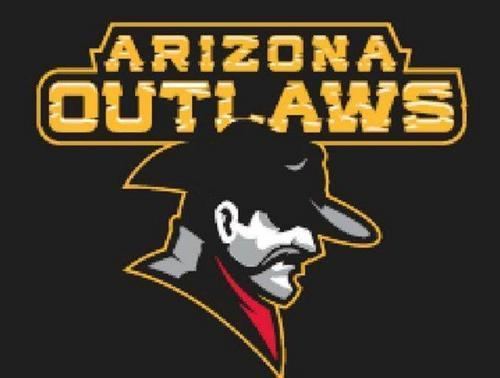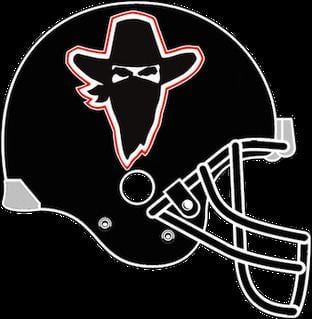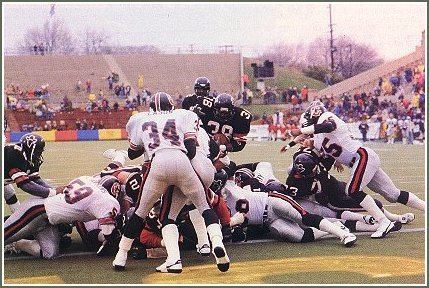Folded 1986 Founded 1984 Based in Tulsa, Tempe | League USFL Conference Western Conference | |
 | ||
Division Central Division (1984)Western Division (1985) Team History Oklahoma Outlaws (1984)Arizona Outlaws (1985) Team colors Black, red, white(1984 – as Oklahoma Outlaws) Black, Red, Copper, White(1985 – as Arizona Outlaws) Home fields Skelly Field at H. A. Chapman Stadium (1984), Sun Devil Stadium (1985) | ||
Arizona outlaws football
The Arizona Outlaws were a professional American football team that played in the United States Football League in the mid-1980s. They were owned by Fresno banker and real estate agent William Tatham, Sr., who had briefly owned the Portland Thunder of the World Football League.
Contents
- Arizona outlaws football
- Arizona outlaws football highlights
- 1984 Oklahoma Outlaws
- Leaving Oklahoma
- Arizona Outlaws
- 1984 Oklahoma Outlaws total roster
- Single season leaders
- Outlaws in video games
- References

Arizona outlaws football highlights
1984 Oklahoma Outlaws

The Outlaws were originally slated to play in San Diego. However, under pressure from baseball's Padres, the NFL's Chargers and the NASL's Sockers, the city refused to grant Tatham a lease for Jack Murphy Stadium.

Scrambling for a home, Tatham seriously considered playing in Honolulu for its inaugural 1984 season, but settled on Tulsa, Oklahoma—even though the city had not even been included in a list of possible expansion sites for the USFL. However, Tatham had roots in Oklahoma (his father had moved to California during the Great Depression), and felt that putting his team there would give something back to the state. He christened his team the Oklahoma Outlaws. The club was the second major-league sports team to play in the state, after the North American Soccer League's Tulsa Roughnecks, and played at Skelly Stadium.
On July 7, 1983, at the same time the USFL announced the expansion team, Tatham introduced Hall of Fame member Sid Gillman, who came out of retirement at age 71 to serve as the Director of Operations. Gillman signed a roster of players, including former Tampa Bay Buccaneers starting QB Doug Williams, but Gillman was fired by Tatham in December in a dispute over finances.
Along with Williams, the Outlaws roster included rookie Oklahoma State star RB Ernest Anderson. Former Pittsburgh Steelers defensive coordinator Woody Widenhofer coached the team. Williams had been one of the biggest NFL stars to bolt to the USFL. He left the Tampa Bay Buccaneers after they offered him a contract that would have still made him among the lowest-paid starters in the league, even though it would have been triple his previous salary. Williams was not a very refined, efficient, or consistent passer at that point in addition to being a little rusty, but had a big arm and a knack for making plays.
The team only drew 15,937 to their first game, a home opener versus the expansion Pittsburgh Maulers on a rainy and cold spring day. (Home openers in the USFL for most teams were the highest attendance games of the season.) Two weeks into the season, Tatham's son, Bill, Jr.--who was serving as general manager despite being fresh out of law school—announced that Skelly Stadium was inadequate for the Outlaws' needs and that they would be playing elsewhere in 1985.
The Outlaws were competitive for much of the first half of the season, starting out 6-2 off the strength of Williams' arm. Unfortunately, the team could not consistently run the ball. (The Outlaws finished with a league worst total of 1537 total rushing yards --- almost 200 yards less than the 17th ranked team.) Two blowout losses sent the team into a downward spiral. They did not win another game that season, dropping 10 straight to finish 6-12.
In spite of those factors, the Outlaws averaged 21,038 fans (in a 40,000-seat stadium), 14th in the league. It might have been even higher if not for brutally cold and wet early-season weather and what amounted to season-long lame duck status. While Tulsa as a USFL host city had a number of legitimate problems, fan turnout was surprisingly respectable, especially compared to the crippling attendance numbers seen by USFL teams in Chicago (7,455), Washington (7,694) and Los Angeles (15,361). They were also one of eight teams whose average attendance was 45 percent or more of listed capacity. The Outlaws would draw decent crowds of 25,403, 21,625, 22,017 and 29,324 later in the season.
During the team's season in Tulsa, all six of their wins came during inclement weather, 4 at home. Wins against Pittsburgh, Michigan, Houston, at Washington, and San Antonio came in rainy conditions, and a win against Chicago came in a Chicago snow storm.
Leaving Oklahoma
The Tathams were looking for a larger market with an acceptable stadium. The Tathams nearly had a deal to merge the Outlaws with the Oakland Invaders. However, the deal collapsed at the last minute because Invaders owner Tad Taube was unwilling to give control of the team to the younger Tatham, who had by this time acquired a reputation as the enfant terrible of the league. This left the team homeless and looking at their options.
Ultimately, the Tathams would turn to the 1984 Western Conference Champion Arizona Wranglers. Despite fielding a much more competitive team after essentially trading rosters with the Chicago Blitz, the Wranglers' 1984 attendance figures --- although respectable --- were not enough to cover expenses. In fact, they were actually slightly below those of the 1983 Wranglers team. Owner Dr. Ted Diethrich, who had swapped the Blitz for the Wranglers in the 1983–84 offseason, had anticipated much higher attendance after bringing most of a team reckoned as an NFL-caliber unit to Phoenix. Despite advancing to the championship game, Dietrhich wanted out after losing millions for the second year in a row. He sold the Wranglers' assets to Tatham, and Tatham relocated the Outlaws to Arizona for the 1985 season as the Arizona Outlaws, and took the Wranglers' place at Arizona State University's Sun Devil Stadium. Since Tatham inherited all of the Wranglers' player contracts, this deal was reported by some outlets as a merger. As a result, Arizona received what amounted to its third USFL team in as many seasons.
Arizona Outlaws
The Outlaws retained many of the better players off both rosters, but not all of them. Rather than retaining the majority of the 1984 Western Conference Champion Wranglers and simply replacing the retiring QB Greg Landry with Williams, for the second year in a row little effort was made to retain players in which Arizona fans felt a vested interest. Tatham did, however, name former Sun Devils coach Frank Kush as head coach. Kush was a hard-nosed, run-oriented coach who had struggled as coach of the NFL's Baltimore/Indianapolis Colts, largely because he had little luck handling professional quarterbacks. Although very much an icon in the region due to his successful 21-year tenure at ASU, he was a surprising choice to team with Doug Williams.
In the instance of mergers, the league ran allocation drafts to send players to other teams. The Tathams allowed several of the better players on the Wranglers to be dispersed. In this way Wrangler star HB Tim Spencer, for example, ended up starting for Memphis in 1985. Other key Wranglers joined Landry in retirement or defected to other leagues (ex. CB Frank Minnifield who left in the 1984 season). Wrangler lead receiver Trumaine Johnson actually held out for the full season.
The 1985 season was very much a replay of 1984, with the Outlaws struggling after a quick start. The team jumped out to a 4-2 start, including a 31-13 pounding of the Herschel Walker and Doug Flutie-led New Jersey Generals. However, they proceeded to drop six in a row, and seven out of eight. They rebounded to win three straight, but did not get enough help to make the playoffs, and finished 8-10.
The Outlaws were a much better rushing team in 1985 totalling 2019 yards in support of Williams and the passing game.
As had been the case with both versions of the Wranglers, Phoenix-area fans largely viewed the Outlaws with indifference. For the second year in a row, attendance dropped --- from the 25,568 George Allen's Wranglers' drew the year before, to 17,881. The crowds looked even smaller than that due to the spacious configuration of Sun Devil Stadium. The Outlaws actually drew 4,000 fewer fans than they did in Tulsa, even though Sun Devil Stadium was almost double the size of Skelly Stadium. Despite this, the Tathams hoped to stick it out once the league won their lawsuit against the NFL.
The Outlaws were one of eight teams slated to play in 1986. After the Portland Breakers folded while the antitrust trial was still underway, the Outlaws were the only team west of the Mississippi River left in the league. By this time, the Tathams had become some of the louder voices among the owners hoping to force a merger with the NFL (in which case their investment would more than double). While the league won the suit, it only received a nominal award of $1 (trebled to $3 under antitrust law). The Outlaws, and the rest of the league, had been counting on the lawsuit money to finance their move to the fall and bail out their unsustainable spending. As the league had essentially staked its future on winning a hefty award in court, it suspended operations never to return.
In a last-ditch desperation move, in January 1987, Tatham met with the Canadian Football League hoping to merge the Outlaws, along with any other USFL team that was willing and able, with the CFL. Under Tatham's proposal, the Outlaws would abide by the CFL's Canadian-born player quotas. The CFL's owners, who were facing their own financial crisis due to the loss of its television sponsorship, were lukewarm to the proposal declined the offer.
Professional football in the Valley of the Sun would not be gone for long: the St. Louis Cardinals moved into Sun Devil Stadium for the 1988 NFL season.
1984 Oklahoma Outlaws total roster
COACHING STAFF: Head Coach: Woody Widenhofer
Offensive Coordinator/QBs – Ed Chlebek; Offensive Line – Charlie Butler; Running Backs – Frank Novak; Receivers/Spec. Teams – Wright Anderson; Defensive Coordinator/Secondary – Jim Johnson; Tim Mills Defensive Line – Ralph Staub; Linebackers – Jim McKinley; Strength & Conditioning – Bert Jacobson; Trainer – Keith Jones, Equipment Mgr. – Bud Turk
Single season leaders
Rushing Yards: 1031 (1985), Reggie Brown
Receiving Yards: 1087 (1984), Alphonso Williams
Passing Yards: 3645 (1985), Doug Williams
Outlaws in video games
The Outlaws' logo can be found in Madden NFL's Create-A-Team Feature. They are also featured in Blitz: The League, the Arizona Outlaws are a Division 3 team and are the first opponents against the player's created team.
